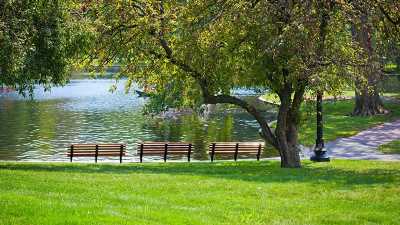Exposure to natural environments may lower hospitalizations for patients with neurodegenerative disorders, new research suggests.
In a large, open-cohort study, living in areas rich with greenery, parks, and waterways (blue space) was linked to fewer hospitalizations for Parkinson’s disease (PD); and residing near green spaces was associated with fewer hospitalizations for Alzheimer’s disease and related dementias (ADRD).

Dr Jochem Klompmaker
These results should be useful to policymakers and urban planners, lead study author Jochem O. Klompmaker, PhD, postdoctoral researcher, Department of Environmental Health, Harvard T. H. Chan School of Public Health, Boston, Massachusetts, told Medscape Medical News.
They also provide clinicians with more evidence of the importance of being close to nature and of encouraging patients to take more walks, Klompmaker noted.
“If they live near a park, that could be a good place to be more physically active and reduce stress levels,” he said.
The findings were published online December 20 in JAMA Network Open.
Three Natural Environments
AD and PD are the most prevalent neurologic diseases in the United States ― and will likely become even more common owing to longer life expectancy, the investigators note.
Because there are no cures for ADRD or PD, it is important to identify modifiable risk factors, they add.
Previous research has shown an association between environmental exposures and AD and PD. However, past studies focused mainly on greenery.
The current study examined associations between ADRD and PD hospital admissions and three natural environments: parks, blue space, and green space.
The study included about 61.7 million fee-for-service Medicare beneficiaries at least 65 years of age and living in the US.
Researchers examined first hospital admissions with a primary or secondary discharge diagnosis of ADRD or PD. There were 7,737,609 such hospitalizations for ADRD and 1,168,940 for PD from 2000 to 2016.
The study used ZIP codes to determine exposures. To measure greenness, the investigators used satellite images to calculate the normalized difference vegetation index (NDVI). The NDVI ranges from −1 to 1, with larger values indicating higher levels of live vegetation, which could include trees, gardens, and agricultural crops.
For park exposure, the researchers used the US Geological Survey Protected Areas Database to determine land types likely used by the public for outdoor recreation, such as playgrounds and basketball courts. They calculated the percentage park cover for each ZIP code.
Blue space includes surface water, such as rivers and lakes. Satellite image data were used to calculate spatially weighted mean blue space values for each ZIP code.
Covariates included age, sex, race/ethnicity, and Medicaid eligibility as a proxy for low socioeconomic status (SES). Additional SES indicators included median household income, Klompmaker noted.
Hazard ratios (HRs) for NDVI and percentage park cover were expressed per interquartile range (IQR) difference. HRs of blue space cover (≥1%) were compared with the reference category (<1% blue space cover).
Differences by Exposure
Results showed that NDVI was associated with a decrease in ADRD hospitalizations after adjustment for potential confounders (HR, 0.95; 95% CI, 0.94 – 0.96 per IQR increase).
There was no evidence of an association between percentage park cover and blue space cover with ADRD hospitalization.
However, all three exposures were associated with a decrease in PD hospitalizations after adjustments. The HRs were 0.94 (95% CI, 0.93 – 0.95) for NDVI, 0.97 (95% CI, 0.97 – 0.98) for percent park cover, and 0.97 (95% CI, 0.96 – 0.98) for blue space cover of at least 1%.
ZIP codes with higher NDVI had lower air pollution levels, which may explain part of the effect, said Klompmaker. “When we adjust for air pollution, we saw effects of greenness became less strong,” he added.
Results by neighborhood SES differed between exposures. For example, for PD hospitalization, associations of percentage park cover were greatest in low-SES ZIP codes ― while associations of NDVI were greatest for ZIP codes with higher SES.
When evaluating associations only in urban ZIP codes, researchers found that associations were similar to those of the full cohort. This was “a little surprising,” as previous studies showed that associations were generally stronger in urban areas, Klompmaker noted.
It is not clear why outcomes for ADRD and PD varied, he added. “PD and AD are different diseases, so there may be different relations between specific exposures,” he said.
Further analysis showed that more exposure to natural environments could decrease hospitalizations.
Assuming the study’s modeling and observed associations are correct, if NVDI and park cover increased by half an IQR and blue space increased to 1% or more in all ZIP codes, about 15,000 ADRD and 4000 PD hospitalizations could be prevented each year, Klompmaker said.
“Not a Stretch”
Commenting for Medscape Medical News, Michael S. Okun, MD, chair of neurology at University of Florida Health, Gainesville, and medical advisor for the Parkinson’s Foundation, said the results make sense.
“Natural environments have been associated with less cardiac disease and less depression; and it would not be a stretch to consider there are less neurodegenerative disease hospitalizations when folks spend time in natural environments,” said Okun, who was not involved with the research.
He noted the conflicting results from studies of natural environments as being potentially associated with neurodegenerative diseases. “One tricky element has been controlling for air pollution in urban areas,” he said.
Still, exposure to natural environments may reduce stress, restore attention, and increase activity and social interactions, all of which improve cognition, said Okun.
The study was funded by grants from the National Institute of Environmental Health Sciences, the National Institute on Aging, the National Heart, Lung, and Blood Institute, and the National Institute on Minority Health and Health Disparities. Klompmaker received a grant from the National Institutes of Health during the conduct of the study. Okun has disclosed no relevant financial relationships.
JAMA Netw Open. Published December 20, 2022. Full text
For more news, follow Medscape on Facebook, Twitter, Instagram, and YouTube.
Source: Read Full Article
